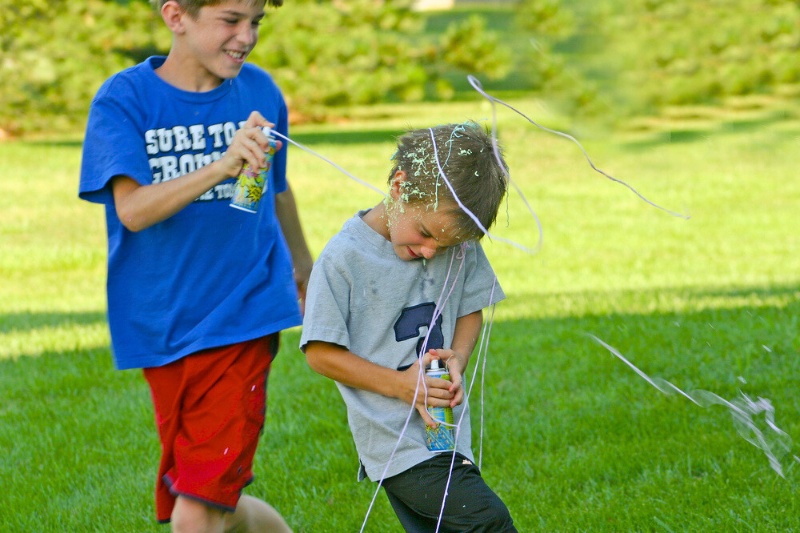Does Silly String Stain? The Ultimate Guide To Understanding And Solving The Mystery
Ever wondered if Silly String actually stains your favorite surfaces? Well, buckle up, because we're diving deep into the world of this iconic party favorite. If you're here, chances are you've had a close encounter with Silly String—whether at a birthday bash, Halloween party, or just an impromptu backyard war. But the burning question remains: does Silly String stain? Let’s unravel the mystery together.
Let’s face it, Silly String is one of those classic toys that never gets old. From kids to adults, everyone loves to spray it around and have a blast. But with all the fun comes a bit of responsibility. You don’t want to ruin your favorite outfit or your brand-new couch, right? That’s why understanding whether Silly String stains is crucial if you want to keep the fun going without the stress.
In this article, we’ll break down everything you need to know about Silly String and its potential to leave unwanted marks. From surfaces to fabrics, we’ll cover it all. So, grab a snack, sit back, and let’s get to the bottom of this sticky situation. Literally.
Read also:Discover Corey Feldman Net Worth Age And Personal Life 2023
What is Silly String Anyway?
Before we dive into whether Silly String stains, let’s take a quick look at what it actually is. Silly String has been around since the early 1970s, and it’s essentially a pressurized spray that shoots out a string-like substance. It’s made from a combination of resin and a propellant, which allows it to expand and form those colorful, curly strings we all know and love. But here’s the kicker—what’s in that can could either be harmless fun or a potential headache.
Does Silly String Stain? The Short Answer
Alright, let’s cut to the chase. Does Silly String stain? The answer is—it depends. While Silly String is designed to be temporary and easy to clean, there are certain surfaces and materials where it might leave behind a stubborn mark. Fabrics, porous surfaces, and even some painted walls can fall victim to Silly String’s antics if not cleaned promptly. But don’t panic just yet—we’ve got solutions for you.
Surfaces Most at Risk of Staining
Not all surfaces are created equal when it comes to Silly String. Here’s a quick rundown of the surfaces that might be more prone to staining:
- Fabrics: Clothes, upholstery, and carpets are some of the most vulnerable surfaces. The fibers can trap the resin, making it harder to remove.
- Painted Walls: While most modern paints are designed to be stain-resistant, older or low-quality paint might not fare as well against Silly String.
- Wood: Unsealed wood surfaces, like furniture or floors, can absorb the resin, leading to discoloration.
- Carpet: Carpets are notorious for holding onto stains, and Silly String is no exception. The deeper the fibers, the harder it is to clean.
Why Does Silly String Sometimes Stain?
So, why does Silly String stain some surfaces but not others? The secret lies in the materials used to make it. The resin in Silly String is what gives it its stringy texture, but it’s also what can cause staining if it’s not removed quickly. When the resin dries, it can bond with certain surfaces, making it difficult to wipe away. Plus, the propellant used in the can might contain chemicals that react differently with various materials.
Understanding the Chemistry Behind Silly String
For those of you who love a bit of science, here’s a breakdown of what’s inside your Silly String can:
- Resin: The main ingredient that forms the stringy texture.
- Propellant: The gas that pushes the resin out of the can.
- Colorants: The dyes that give Silly String its vibrant colors.
While the resin itself isn’t inherently harmful, the combination of these ingredients can sometimes lead to staining, especially if left untreated.
Read also:Exploring The Influence Of Lays Peace Erome On Modern Society
How to Prevent Silly String Stains
Prevention is always better than cure, and when it comes to Silly String, a little preparation can go a long way. Here are some tips to help you avoid stains:
- Cover Surfaces: Use old sheets or drop cloths to protect furniture, floors, and walls during Silly String adventures.
- Test in a Hidden Area: Before letting loose, test the Silly String on a small, inconspicuous area to see how it reacts with the surface.
- Act Quickly: If Silly String does land on a surface, clean it up as soon as possible to prevent it from setting.
Effective Ways to Remove Silly String Stains
Even with the best precautions, accidents happen. But don’t worry—we’ve got you covered with some effective methods to remove Silly String stains:
For Fabrics:
When Silly String hits your clothes or upholstery, here’s what you can do:
- Blot, Don’t Rub: Gently blot the affected area with a clean cloth to lift the resin without spreading it.
- Use Warm Water: Soak the fabric in warm water for a few minutes, then rinse thoroughly.
- Apply Dish Soap: A few drops of dish soap can help break down the resin. Rub it gently into the stain and rinse again.
For Hard Surfaces:
For walls, floors, and furniture, try these steps:
- Scrape Gently: Use a plastic scraper or credit card to lift the dried resin off the surface.
- Wipe with Vinegar: A solution of equal parts water and white vinegar can help dissolve any remaining residue.
- Polish if Needed: For wood surfaces, finish with a wood polish to restore shine.
Common Myths About Silly String Stains
There are a lot of myths floating around about Silly String and its staining potential. Let’s debunk a few of them:
- Myth: Silly String Only Stains Dark Surfaces. Fact: Silly String can stain any surface if the resin bonds with it, regardless of color.
- Myth: Once It Dries, It’s Permanent. Fact: While dried Silly String can be harder to remove, it’s not impossible with the right cleaning methods.
- Myth: All Silly String is the Same. Fact: Different brands and formulations can behave differently, so always check the label for cleaning instructions.
Professional Tips for Handling Silly String
If you’re still unsure about tackling Silly String stains on your own, here are some professional tips to keep in mind:
- Hire a Cleaner: For large or stubborn stains, consider hiring a professional cleaner who specializes in removing difficult residues.
- Use Commercial Cleaners: There are specific cleaning products designed to tackle resin-based stains, which might be more effective than homemade solutions.
- Consult the Manufacturer: If you’re using a specific brand of Silly String, reach out to the manufacturer for their recommended cleaning methods.
Conclusion: Does Silly String Stain?
So, does Silly String stain? The answer is yes, but only if you let it. With a little knowledge and preparation, you can enjoy all the fun of Silly String without the worry of stains. Remember to act quickly, use the right cleaning methods, and protect your surfaces beforehand. And if all else fails, don’t hesitate to seek professional help.
Now that you’re armed with the facts, go ahead and have some fun with Silly String. Just be sure to share this article with your friends so they can avoid the same pitfalls. And hey, if you’ve got any tips or tricks of your own, drop them in the comments below—we’d love to hear from you!
Table of Contents
- What is Silly String Anyway?
- Does Silly String Stain? The Short Answer
- Surfaces Most at Risk of Staining
- Why Does Silly String Sometimes Stain?
- How to Prevent Silly String Stains
- Effective Ways to Remove Silly String Stains
- Common Myths About Silly String Stains
- Professional Tips for Handling Silly String
- Conclusion: Does Silly String Stain?


